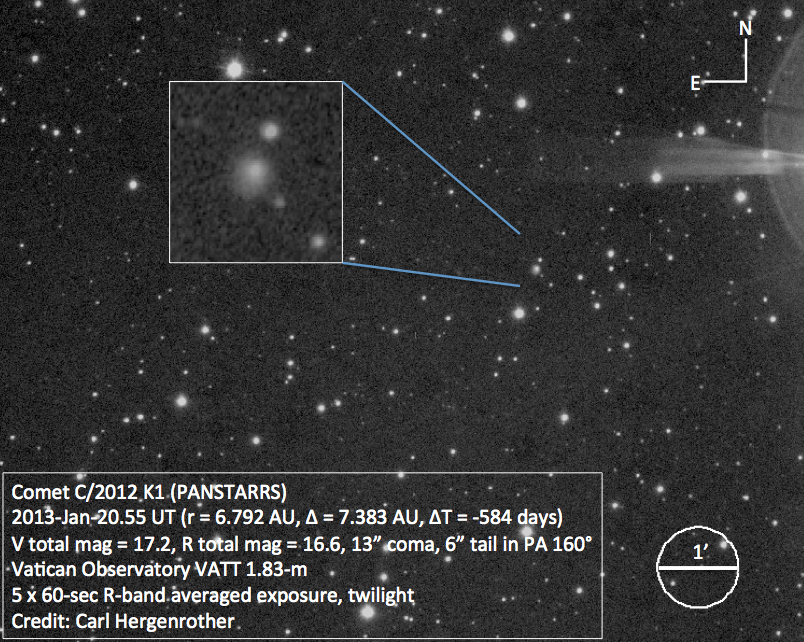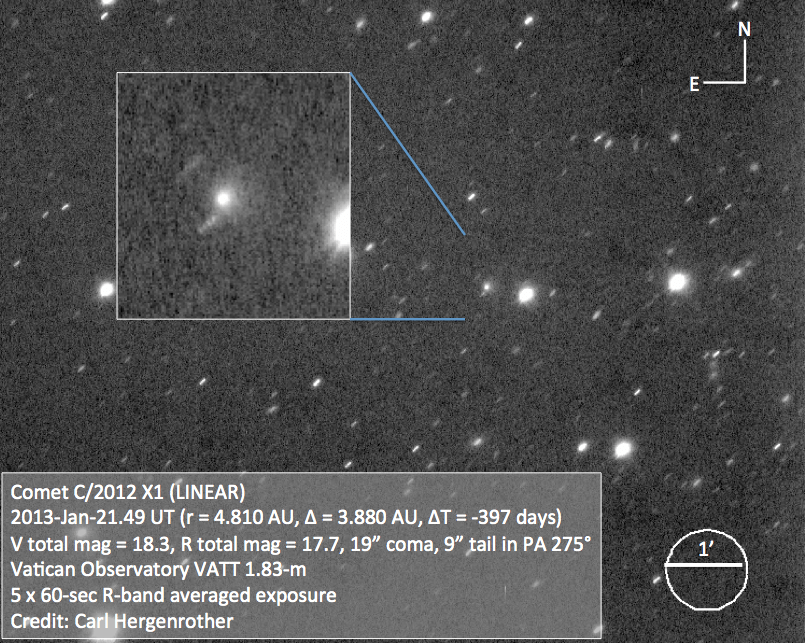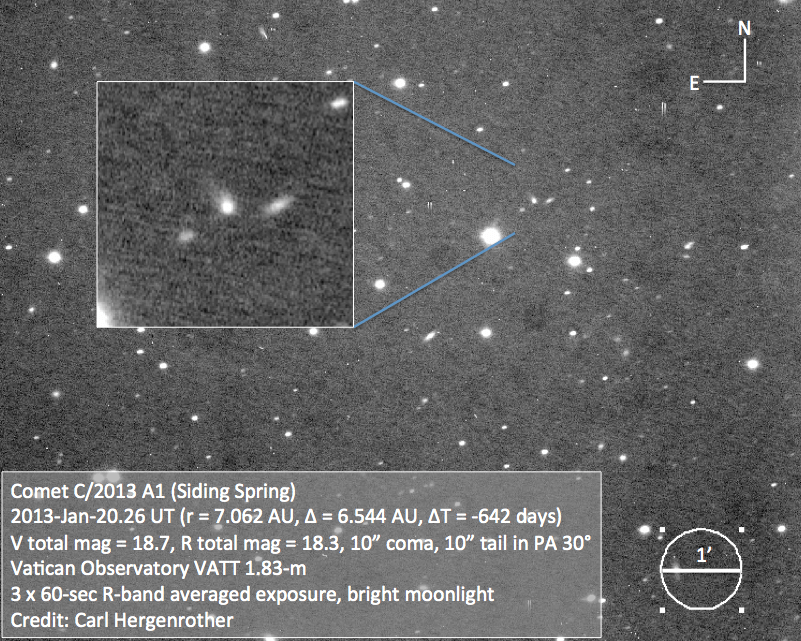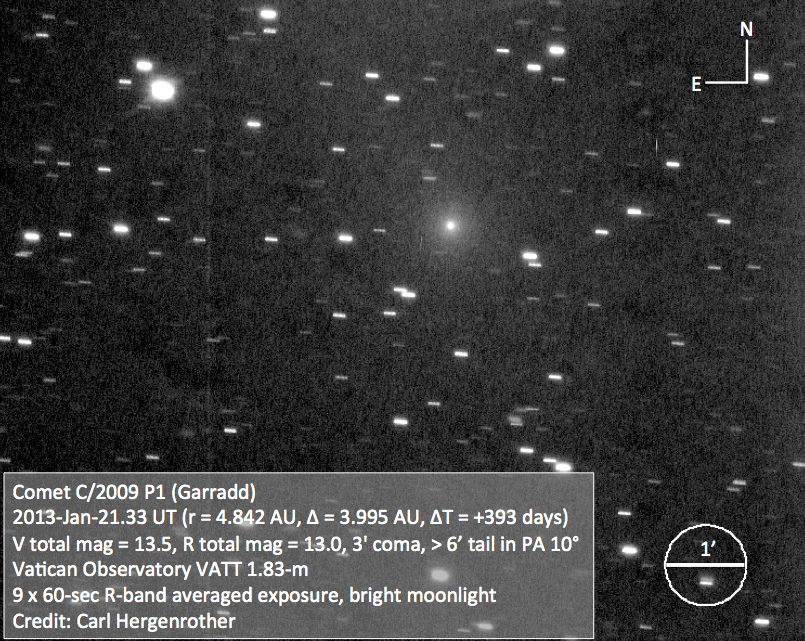Last week I spent three nights observing asteroids and comet with the Vatican Observatory’s 1.8-m VATT telescope on Mount Graham in southeastern Arizona. The observing run was part of my program to characterize asteroids that could be good spacecraft targets as well as objects that are analogous to the OSIRIS-REx target asteroid. When possible I never pass up the opportunity to observe a few comets.
Though clouds affected two of the nights, the conditions were rather good. In fact, the seeing was exceptional and was as good as 0.7″ at times.
As luck would have it, the brightest comets in the sky were not visible from the VATT either because they were too far south or too close to the Sun for observation (or in the case of C/2012 K5, I just couldn’t fit it into my observing schedule).
The following is an update on a few long-period comets with some images I took from the VATT.
C/2011 L4 (PANSTARRS)
 The big comet of the spring is supposed to be comet C/2011 L4 (Panstarrs). When discovered back in June of 2011 the brightness of the comet at a distance of ~8 AU (halfway between the distances of Jupiter and Saturn) suggested this comet could be a brilliant negative magnitude at perihelion in March of this year.
The big comet of the spring is supposed to be comet C/2011 L4 (Panstarrs). When discovered back in June of 2011 the brightness of the comet at a distance of ~8 AU (halfway between the distances of Jupiter and Saturn) suggested this comet could be a brilliant negative magnitude at perihelion in March of this year.
There was some questions whether this comet was on its first passage through the inner Solar System or if it had been through the neighborhood before. This is an important distinction because comets fresh from the Oort cloud have a tendency of being very active while far from the Sun. Then as the most volatile ices are sublimed off, the comet settles down into a less active state and never gets quite as bright as predicted. We have seen this many times in the past with comets being lauded as “great” or “future” comets, only to disappoint when they finally reach perihelion. Comet Cunningham in 1941, Kohoutek in 1973/74 and Austin in 1990 are prime examples
Comet PANSTARRS has an orbit that is almost indistinguishable from parabolic meaning the comet is likely to be a fresh comet from the Oort cloud. This fact had many people doubting whether it would really reach magnitude -1 as predicted by its early behavior. Now that the comet is once again observable (though only from the Southern Hemisphere) it does appear the comet’s brightening has slowed down and the comet will only reach a magnitude of +2 to +3 if that.
Recent visual observations place the comet between magnitude 7.0 and 7.5. It will continue to be a southern-only comet till mid-March when it will become visible in the early evening sky for northern observers. Sky and Telescope has some nice finder charts for the comet here. Even with a peak brightness of “only” 2nd or 3rd magnitude, the comet will be quite a sight in binoculars and small telescopes.
C/2012 F6 (Lemmon)
 If Comet PANSTARRS is an example of the “over-hyped” comet that is “under-performing”, Comet Lemmon is the exact opposite. When discovered by the Mount Lemmon Survey last March, the comet was nothing special. Even with a perihelion distance of only 0.73 AU, the comet looked too faint to amount to much. I even placed it on my watch list for small comets that were likely to disintegrate and not survive perihelion. Instead this comet has been brightening at a much faster rate than predicted and is now the brightest comet in the sky.
If Comet PANSTARRS is an example of the “over-hyped” comet that is “under-performing”, Comet Lemmon is the exact opposite. When discovered by the Mount Lemmon Survey last March, the comet was nothing special. Even with a perihelion distance of only 0.73 AU, the comet looked too faint to amount to much. I even placed it on my watch list for small comets that were likely to disintegrate and not survive perihelion. Instead this comet has been brightening at a much faster rate than predicted and is now the brightest comet in the sky.
Back on January 9 I spotted it in my 30×125 binoculars at magnitude 7.9. It was an easy object even though it only got ~10° above the horizon as it was speeding to the south. Its southward motion now means the comet is only visible for Southern Hemisphere observers.
The most recent visual observations place is around magnitude 6.5. If it continues like this it could rival or even surpass Comet PANSTARRS in brightness at magnitude +2 to +3 when it reaches perihelion at the end of March. For those of us up north the comet will again become visible in late April/ early May. At the time the comet will be fading but should still be around 5th magnitude.
273P/Pons-Gambart
 The surprise return of Pons-Gambart has been discussed in earlier posts (here, here, and here). After spending a month too close to the Sun for Earth-based observations, the comet is once again visible between magnitude 8.5 and 9.0. The comet may remain brighter than magnitude 10 and within range of small telescope users for another month or so.
The surprise return of Pons-Gambart has been discussed in earlier posts (here, here, and here). After spending a month too close to the Sun for Earth-based observations, the comet is once again visible between magnitude 8.5 and 9.0. The comet may remain brighter than magnitude 10 and within range of small telescope users for another month or so.
Pons-Gambart has a period of ~188 years. It was seen once before in 1827 during its last perihelion passage. Its period will actually shorten by a few years results in the next return in 2191.
.
.
.
.
C/2012 K1 (LINEAR)
 Discovered on May 19, 2012 by the LINEAR survey at a faint 19-20th magnitude, the comet was then located at a distant 8.8 AU from the Sun. It is now ~6.8 AU out and has brightened to magnitude ~17.2. Though the comet does not look like much, it will get much brighter as it approaches its August 27, 2014 perihelion at a distance of 1.05 AU from the Sun.
Discovered on May 19, 2012 by the LINEAR survey at a faint 19-20th magnitude, the comet was then located at a distant 8.8 AU from the Sun. It is now ~6.8 AU out and has brightened to magnitude ~17.2. Though the comet does not look like much, it will get much brighter as it approaches its August 27, 2014 perihelion at a distance of 1.05 AU from the Sun.
Right now the comet looks on track to reach 6th magnitude at perihelion, but… similar to Comet PANSTARRS, C/2012 K1 is also an Oort cloud comet making its first visit to the inner Solar System. It is likely that it will also experience a slow down in brightening and will not get as bright as predicted. Time will tell …
In the here and now, the VATT showed K1 to be a nice small condensed comet at 17th magnitude.
C/2012 S1 (ISON)
Comet ISON is the big one. Many media outlets are already calling this one the “Comet of the Century” which will shine brighter than the Full Moon. Possibly…
 As the lesson of Comet PANSTARRS has taught us, the past behavior of a comet does not guarantee its future performance.The aforementioned Comets Cunningham and Kohoutek were also called “Comets of the Century” in their time. Neither lived up to the moniker.
As the lesson of Comet PANSTARRS has taught us, the past behavior of a comet does not guarantee its future performance.The aforementioned Comets Cunningham and Kohoutek were also called “Comets of the Century” in their time. Neither lived up to the moniker.
ISON does have a few things going for it. The best news is its orbit which is very similar to the Great Comet of 1680. It is doubtful that ISON and the 1680 comet are one and the same. It is possible that the two comets are pieces of an older comet that split in the past. Simply being related to the 1680 comet does not mean ISON will be as spectacular as that comet but it does mean ISON has been around before and is not a new Oort cloud comet. This bodes well for ISON to brighten at a good rate and also survive perihelion.
A year ago, Comet C/2011 W3 (Lovejoy) passed even closer to the Sun than ISON will. Though Lovejoy disintegrated a few days past perihelion that was still enough time for it to produce a long bright tail that was observable for weeks (only for southern observers though, Lovejoy was invisible for Northern Hemisphere observers after perihelion). If ISON can survive it close brush with the Sun by even a few days it will produce a long bright tail that should be easily visible by northern observers (sorry southerners, ISON is our turn to enjoy a brilliant sun-grazing/skirting comet) throughout the month of December 2013.
When it reaches perihelion this November 28 (Thanksgiving Day!) it will be located only 0.012 AU from the center of the Sun or ~1.1 million km (660,000 miles) from the Sun’s surface which just under 3 times the distance from the Earth to the Moon. (Editors Note: Thanks to Joe Stieber for pointing out the error in my perihelion Sun distance!) Right now ISON is currently located at ~5 AU (the distance of Jupiter) from the Sun and still has almost 10 months to go before perihelion.
The VATT found ISON to be a nice compact 15th magnitude comet wandering among the stars of Gemini.
C/2012 T5 (Bressi)
 From a potential great comet to an absolute runt of a comet. Comet Bressi was first spotted by Spacewatch observer Terry Bressi from Kitt Peak on October 14, 2012. If any of the comets in this blog post are likely to not survive perihelion, this is the one.
From a potential great comet to an absolute runt of a comet. Comet Bressi was first spotted by Spacewatch observer Terry Bressi from Kitt Peak on October 14, 2012. If any of the comets in this blog post are likely to not survive perihelion, this is the one.
The comet is currently just within 1 AU of the Sun and little over 1 AU from Earth. Even after a recent outburst a week or two ago the comet is still rather faint. My observations place it at V magnitude 13.0 but this is most likely an underestimate as the observations were hampered by a very right Moon nearby and the comet’s low elevation. Visual observers place it closer to magnitude 11-12.
Note that unlike most comets in this blog post, Bressi is much brighter in the V versus the R. Most of the more distant comets are actually brighter in the R. The reason is that Bressi is a much more gaseous comet due to its closer distance to the Sun and perhaps even internal composition.
Comet Bressi will reach perihelion on February 24 at a distance of 0.32 AU from the Sun. It will be interesting to see if it survives. If it does it may brighten enough to be seen in small telescopes though observations will be limited to southern observers until March.
C/2012 V2 (LINEAR)
 This LINEAR comet was discovered on November 5. At perihelion on August 16, 2013 at a distance of 1.45 AU from the Sun the comet should be no brighter than 12-13th magnitude. It should remain out of reach of most visual observers.
This LINEAR comet was discovered on November 5. At perihelion on August 16, 2013 at a distance of 1.45 AU from the Sun the comet should be no brighter than 12-13th magnitude. It should remain out of reach of most visual observers.
Last week the VATT caught 2012 V2 out at a distance of ~3.1 AU from the Sun. The comet was magnitude 16 and sported a short tail extending to the northeast.
.
.
.
.
.
C/2012 X1 (LINEAR)
 Yet another inbound Comet Linear, C/2012 X1 was first spotted last month on December 8th. It is currently at a distance of ~4.8 AU from the Sun which is just inside the distance of Jupiter’s orbit. When it reaches perihelion next year on February 21st, it will be 1.60 AU from the Sun. That’s not too close so it should only brighten to about 11th magnitude by then.
Yet another inbound Comet Linear, C/2012 X1 was first spotted last month on December 8th. It is currently at a distance of ~4.8 AU from the Sun which is just inside the distance of Jupiter’s orbit. When it reaches perihelion next year on February 21st, it will be 1.60 AU from the Sun. That’s not too close so it should only brighten to about 11th magnitude by then.
Last week the comet was seen at 18th magnitude with a broad fan tail.
.
.
.
.
.
C/2013 A1 (Siding Spring)
 The first comet to be discovered in 2013 is the most recent comet to be discovered that may become bright enough for backyard observers. Rob McNaught found C/2013 A1 on January 3rd from Siding Spring, Australia. Right now the comet is further from the Sun than Jupiter is at a distance of ~7 AU. The VATT found the comet to be around V magnitude 18.7 with a nice tail to the northeast
The first comet to be discovered in 2013 is the most recent comet to be discovered that may become bright enough for backyard observers. Rob McNaught found C/2013 A1 on January 3rd from Siding Spring, Australia. Right now the comet is further from the Sun than Jupiter is at a distance of ~7 AU. The VATT found the comet to be around V magnitude 18.7 with a nice tail to the northeast
The comet is almost 2 years from perihelion which won’t occur until October 23, 2014 at a distance of 1.39 AU from the Sun. It could become as bright as 7th magnitude at that time though a lot can happen over the next 2 years and the comet may end up significantly fainter.
C/2009 P1 (Garradd)
 The next two comets are examples of objects that were bright enough for small telescope users in the past but are now fading as they leave the inner Solar System.
The next two comets are examples of objects that were bright enough for small telescope users in the past but are now fading as they leave the inner Solar System.
Comet Garradd was a splendid sight for many months between the 2nd half of 2011 and the 1st half of 2012. During that stretch the comet was an easy binocular object of 6th-7th magnitude. Now over a year past its December 2011 perihelion (at a distance of 1.55 AU from the Sun) and 3.5 years since its discovey, the comet has retreated to a distance of 4.8 AU from the Sun which is nearly the distance of Jupiter.
My VATT images from January 20 find the comet at V magnitude 13.5. The comet displays a small condensed coma of ~1′ within a much larger diffuse coma of 3′. The bright inner coma is dust recently released by the comet while the diffuse faint outer coma is dust released when the comet was more active in the past. The fact that we are observing dust released over many months or years does make it difficult to properly measure the current activity level of the comet.
A faint broad tail can also be seen extending towards the north. Too bad the Moon was bright that night and affected the images or the tail and outer coma would have been better defined. This will be a fun comet to watch as it continues its journey back into the depths of the outer Solar System. Based on the latest orbit by Syuichi Nakano, Comet Garradd won’t be back for ~500,000 years.
C/2011 UF305 (LINEAR)
 Another comet on the way out, C/2011 UF305 reached perihelion last July at a rather distant 2.13 AU from the Sun. Though it had a large perihelion distance it did brighten to 10th magnitude for a few months during the summer and fall of 2012.
Another comet on the way out, C/2011 UF305 reached perihelion last July at a rather distant 2.13 AU from the Sun. Though it had a large perihelion distance it did brighten to 10th magnitude for a few months during the summer and fall of 2012.
The comet is now ~230 days past perihelion at a distance of 3 AU from the Sun. My VATT observations yield a V magnitude of ~13.8 which is still bright enough for visual observers with very large backyard telescopes to observe it. For small telescope users, the comet is well out of reach.
Drifting against the stars of Cancer, the comet was near opposition. Similar to C/2009 P1, a large diffuse dust tail can be seen extending towards the north. Most likely this is dust that was released many months ago when the comet was more active. This will also be a fun comet to see how long it can be followed as it recedes into the depth of the outer Solar System. Based on the latest orbit by Syuichi Nakano, Comet Garradd won’t be back for ~90,000 years.










Carl,
As a comet enthusiast I appreciate you taking the time to post this informative information and making it available to us. The pictures are not too shabby either!
Keep up the good work!
Robert Lunsford
Chula Vista, CA
Hi Carl,
Thanks for this very informative post and briefing about the comets you have observed ! Great work !
Erik Bryssinck
Carl,
Great page in a great site!
However, for C/2012 S1 (ISON), how did you arrive at the 470,000 km (282,000 miles) distance from the solar surface at perihelion? (Note: 470,000 km = 292,000 miles.)
I figure, using q = 0.0125 au, 1 au = 149,600,000 km and solar diameter = 1,393,000 km…
(0.0125 x 149,600,000) / (1,393,000 / 2) = 1,174,000 km (730,000 miles)
That assumes the focus of perihelion is the center of the sun. I can’t find a definitive answer to the question of whether comet orbits are calculated relative to the center of the sun or to the barycenter of the solar system, which wanders around and is sometimes outside the surface of the sun depending on the position of the planets (especially Jupiter, and then Saturn). For most comets with a much greater perihelion distance (“q”), the difference might be academic, but Comet ISON comes so close to the sun that the solar radius is a significant fraction of the perihelion distance. If the barycenter is the focus, and it’s not near the center of the sun at ISON’s perihelion, it could noticeably alter the distance from the solar surface.
Joe Stieber
Joe, Thanks for the comment.
You are right about the distance from the Sun. Not sure what I did what my, admittedly, quick back-of-the-envelope calculation. I’m going to go ahead and change the posting to reflect the correct values.
I believe the perihelion distance is relative to the center of the Sun. The JPL Horizons site explicitly states this.
Thanks again for reading and enjoying the site,
– Carl
Comet “Siding Spring” seems to be our ‘Death Star’ if trajectories hold true. If Mars is the bullseye, the ejecta will destroy life on Earth shortly thereafter. It’s interesting that this comet is six times larger that Mars’ moon Phobos and traveling five times faster than the Apollo spacecraft achieved. It’s a wake-up call for Earthlings to know we couldn’t even catch an object like this should it approach Earth.